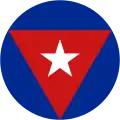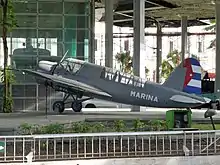| Revolutionary Anti-Air Defence and Air Force | |
|---|---|
| Defensa Anti-Aérea y Fuerza Aérea Revolucionaria | |
 Cuban Armed Forces emblem | |
| Founded | 1959 |
| Country | |
| Type | Air force |
| Role | Aerial warfare Aerial defence |
| Size | 8,000 Personnel |
| Part of | Revolutionary Armed Forces |
| Nickname(s) | DAAFAR |
| Commanders | |
| Notable commanders | Major General Pedro Mendiondo Gómez[1][2] |
| Insignia | |
| Roundel |  |
| Fin flash | .svg.png.webp) |
| Aircraft flown | |
| Fighter | MiG-21, MiG-23, MiG-29 |
| Attack helicopter | Mil Mi-24 |
| Trainer | Aero L-39 |
| Transport | Mil Mi-8, Mil Mi-17, An-24 |
The Cuban Revolutionary Air and Air Defense Force (Spanish: Defensa Anti-Aérea y Fuerza Aérea Revolucionaria) commonly abbreviated to DAAFAR in both Spanish and English, is the air force of Cuba.
History
Background
The Cuban Army Air Force was the air force of Cuba that existed prior to 1959.
Early years under Castro
When the Cuban Revolution overthrew the government of Fulgencio Batista at the end of 1958, the new government led by Fidel Castro inherited most of the aircraft and equipment of the old regime, which was supplemented by the aircraft of the revolutionaries own Fueza Aérea Rebelde,[lower-alpha 1] to form the new Fuerza Aérea Revolucionaria (FAR). Arrests of many of the personnel (including 40 pilots) of the old air force meant that the FAR was short of manpower to operate its aircraft, while lack of spare parts further reduced operational efficiency and a US-inspired arms embargo restricted efforts to acquire replacement aircraft.[4]
In April 1961, CIA-backed Cuban exiles attempted an invasion of Cuba with the aim of overthrowing Castro's government. The invasion was preceded on 17 April by air attacks on Cuban airfields in an attempt to destroy the FAR prior to the invasion, with several FAR aircraft being destroyed.[5] The remaining operational aircraft were deployed against the Cuban exiles landings on 19 April, sinking one transport, the Rio Escondido and badly damaging another, the Houston, which was beached, resulting in the loss of most of the invader's supplies.[6]
In 1969, the inadequacy of the radar coverage to the south of the United States were dramatically illustrated when a Cuban Air Force MiG-17 went undetected before it landed at Homestead Air Force Base, Florida[7] and two years later, an Antonov An-24 similarly arrived unannounced at New Orleans International Airport.[7]
Later years

In the 1980s, Cuba with the help of the Soviet Union was able to project power abroad, using its air force, especially in Africa. During that time Cuba sent jet fighters and transports for deployment in conflict zones such as Angola and Ethiopia.
In 1990, Cuba's Air Force was the best equipped in Latin America. During this time, the Cuban Air Force imported approximately 230 fixed-wing aircraft. Although there is no exact figure available, Western analysts estimate that at least 130 (with only 25 operational[8]) of these planes are still in service spread out among the thirteen military airbases on the island. The Soviet Union was to import 40 of the latest MiG-29s, including fighters and two-seat trainers, but collapsed during this process. Only 5 fighters and 3 trainers were imported..
In 1996, fighters from the DAAFAR shot down two Cessna aircraft based in Florida which were accused of dropping leaflets into Cuban airspace. The Air Force was criticized for not giving the pilots of the aircraft options other than being shot down. One aircraft escaped.[9]
In 1998, according to the same DIA report mentioned above, the air force had 'fewer than 24 operational MIG fighters; pilot training barely adequate to maintain proficiency; a declining number of fighter sorties, surface-to-air missiles and air-defense artillery to respond to attacking air forces.[10]
Organization
By 2007 the International Institute for Strategic Studies assessed the force as 8,000 strong with 41 combat capable aircraft and a further 189 stored. DAAFAR is divided into three territorial commands known as air zones, in each of which there is a Brigade with several independent Regiments and Squadrons. Each regiment has about 30 aircraft, and squadrons can vary in number, but are usually 12-14 aircraft. DAAFAR is known now to have integrated another Mig-29 and a few MiG-23s which makes it 58 combat aircraft in active service which are listed as 6 MiG-29s, 40 MiG-23s, and 12 MiG-21s. There were also assessed to be 12 operational transport aircraft plus trainers which include 8 L-39C and helicopters which are mainly Mil Mi-8, Mil Mi-17 and Mil Mi-24 Hind. Raúl Castro ordered in 2010 that all MiG-29 pilots had to have full training, they now have from 200–250 hours of flight annually together with real dogfight training and exercises. Up to 20 MiG-23 units also have this kind of training but the other 16 MiG-23 units spend more time in simulators than real flight. MiG-21 units have limited time in this exercises and spend more time in simulators and maintain their skills flying with the commercial brand of the air force Aerogaviota.
At San Antonio de los Baños military air field, south west of Havana, several aircraft are visible using Google Earth.[11]
Air bases

Units
- Western Air Zone - 2nd Guards Aviation Brigade "Battle of Girón Beach" (San Antonio de los Baños Airfield)[12]
- 21st Fighter Regiment, San Antonio (interception and air support)
- 211st Fighter Squadron
- 212th Fighter Squadron
- 22nd Fighter Regiment, Baracoa (interception and air support)
- 221st Fighter Squadron
- 222nd Fighter Squadron
- 223rd Fighter Squadron
- 23rd Fighter Regiment, San Antonio and San Julián (interception and air support)
- 231st San Antonio de los Baños Fighter Squadron
- 232nd San Julián Fighter Squadron
- 24th Tactical Support Regiment, Guines
- 241st Fighter Squadron
- 26th Helicopter Regiment, Ciudad Libertad
- 261st General Purpose Helicopter Squadron
- 262nd General Purpose Helicopter Squadron
- 25th Transport Regiment, San Antonio and José Martí
- 251st Transport Squadron, Jose Martí Airport
- 252nd Transportation Squadron, San Antonio de los Baños
- 21st Fighter Regiment, San Antonio (interception and air support)
- "Comandante Che Guevara" Air Force Academy, San Julián
- Central Air Zone - 1st Guards Brigade "Battle of Santa Clara"
- 11th Fighter Regiment, Santa Clara (interception and air support)
- 111th Fighter Squadron
- 112th Fighter Squadron
- 12th Fighter Regiment, Sancti Spiritus (interception and air support)
- 121st Fighter Squadron
- 122nd Fighter Squadron
- 14th Tactical Support Regiment, Santa Clara (fighter-bombers)
- 141st Fighter Squadron
- 16th Helicopter Regiment, Cienfuegos
- 162nd Helicopter Squadron
- 163rd Helicopter Squadron
- Naval Aviation of the Revolutionary Navy, Cienfuegos
- 161st Anti-Submarine Warfare Helicopter Squadron
- 15th Transportation Regiment, Cienfuegos
- 151st Transport Squadron
- 11th Fighter Regiment, Santa Clara (interception and air support)
- Eastern Air Zone - 3rd Guards Aviation Brigade "Moncada Barracks"
- 31st Fighter Regiment, Camagüey (interception and air support)
- 311st Fighter Squadron
- 312th Fighter Squadron
- 34th Tactical Support Regiment, Holguín (fighter-bombers)
- 341st Fighter Squadron
- 36th Helicopter Regiment, Santiago de Cuba
- 361st Combat Helicopter Squadron
- 362nd Helicopter Squadron
- 363rd Helicopter Squadron
- 35th Transport Regiment, Santiago de Cuba
- 351st Transport Squadron
- 31st Fighter Regiment, Camagüey (interception and air support)
Source: [13]
2nd Guards Aviation Brigade "Girón Beach"
The 2nd Guards "Playa Girón" Aviation Brigade, based in San Antonio de los Baños, is an elite unit of the DAAFAR. The San Antonio de los Baños air base was built at the end of World War II. In 1976, the unit stationed that received the current name of the Playa Girón Guards Aviation Brigade. In April 1961, was responsible for the defense of Cuba during the Bay of Pigs Invasion.[14] Among its notable members was Cuban cosmonaut Arnaldo Tamayo Méndez. It is a recipient of the Antonio Maceo Order, which was awarded to it in 2014 on its 55th anniversary.[15] In October 2019, the regiment called for the immediate release of former Brazilian President and leader of the Workers Party, Luis Inacio Lula da Silva.[16]
Aircraft
.jpg.webp)

Current inventory
| Aircraft | Origin | Type | Variant | In service | Notes | |
|---|---|---|---|---|---|---|
| Combat Aircraft | ||||||
| MiG-21 | Soviet Union | Interceptor | 11[17] | |||
| MiG-23 | Soviet Union | fighter | Unknown | 24[17] Retired | ||
| MiG-29 | Soviet Union | multirole | 3[17] | |||
| Transport | ||||||
| Antonov An-26 | Soviet Union | transport | 1[17] | 2 crashed | ||
| Helicopters | ||||||
| Mil Mi-8 | Soviet Union | utility | Mi-8/17 | 10[17] | ||
| Mil Mi-24 | Russia | attack | Mi-35 | 4[17] | ||
| Trainer Aircraft | ||||||
| Aero L-39 | Czechoslovakia | jet trainer | 26[17] | |||
Notes
- ↑ The Fuerza Aérea Rebelde consisted mainly of transports and light aircraft, which were used to carry arms and personnel to the rebel fighters, but also included three P-51 Mustang fighter aircraft and a T-28 armed trainer.[3]
References
- ↑ "Preguntas sin respuestas en muerte de jefe militar".
- ↑ "FALLECIÓ EL GENERAL DE BRIGADA PEDRO J. MENDIONDO GÓMEZ, JEFE DE LA DEFENSA ANTIAÉREA y FUERZA AÉREA REVOLUCIONARIA CUBANA". 27 August 2013.
- ↑ Hagedorn 1993, pp. 146–147
- ↑ Hagedorn 1993, pp. 26–27
- ↑ de Quesada 2009, pp. 20–21
- ↑ de Quesada 2009, pp. 27, 29
- 1 2 Leonard, p. 172
- ↑ Cuban Armed Forces Review: Air Force Archived 2009-02-10 at the Wayback Machine
- ↑ Sections 3.18, 3.19 and 3.20 of the Resolution on the Cuban Government's Shootdown of Brothers to the Rescue Adopted by the Council of the International Civil Aviation Organization (ICAO) at the Twentieth Meeting of its 148th Session on 27 June 1996 Archived 2015-09-24 at the Wayback Machine
- ↑ Jane's Defence Weekly, 13 May 1998
- ↑ https://maps.google.com/maps?hl=en&q=22+52%2728.40%22+N+82+30%2726.04%22+W&ll=22.874643,-82.506809&spn=0.004557,0.006899&t=h&z=17 Google Earth imagery of San Antonio de los Banos airfield
- ↑ "Defensa antiaérea y revolucionaria Fuerza Aérea | Enciclopedia KripKit.com". kripkit.com. Retrieved 2021-03-15.
- ↑ "The Cuban Revolutionary Air Force Today. Equipment • Rubén Urribarres". Cuban Aviation • Rubén Urribarres. Retrieved 2021-03-15.
- ↑ Infodefensa.com (2014-09-08). "La unidad élite de la Fuerza Aérea de Cuba celebra su 55 aniversario - Noticias Infodefensa América". Infodefensa.com (in Spanish). Retrieved 2021-03-13.
- ↑ Ceremonia Militar por el aniversario de la brigada de Aviacion Playa Giron, retrieved 2021-03-13
- ↑ Ariguanabo, Radio. "Aviation Regiment demands Lula's freedom". Radio Artemisa Digital English Digital Edition. Retrieved 2021-03-13.
- 1 2 3 4 5 6 7 "World Air Forces 2023". Flight Global. Flightglobal Insight. 2024. Retrieved 30 November 2023.
Bibliography
- Hagedorn, Daniel P. (1993). Central American and Caribbean Air Forces. Tonbridge, Kent, UK: Air-Britain (Historians) Ltd. ISBN 0-85130-210-6.
- Hagedorn, Daniel P. (September–October 1996). "Talkback". Air Enthusiast (65): 80. ISSN 0143-5450.
- de Quesada, Alejandro (2009). The Bay of Pigs: Cuba 1961. Elite series. Vol. 166. Oxford: Osprey Publishing Ltd. ISBN 978-1-84603-323-0.
- Reinhard, Martin A. (January–February 2004). "Talkback". Air Enthusiast. No. 109. p. 74. ISSN 0143-5450.